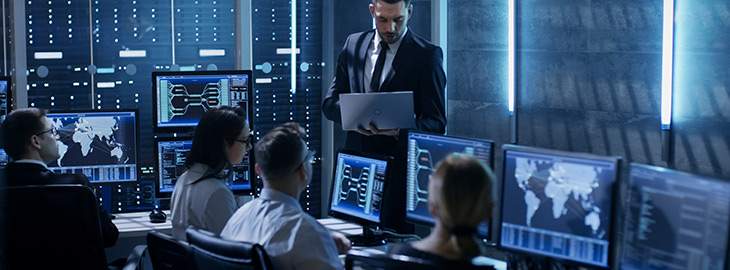Grasping Corporate Security: Proven Methods for Organization Defense
Grasping Corporate Security: Proven Methods for Organization Defense
Blog Article
From Cybersecurity to Physical Actions: Strengthening Corporate Security in an Altering World
By incorporating the strengths of both cybersecurity and physical safety, firms can develop an extensive defense strategy that deals with the diverse range of risks they face. In this discussion, we will certainly explore the changing threat landscape, the demand to incorporate cybersecurity and physical security, the application of multi-factor authentication actions, the significance of employee recognition and training, and the adjustment of security steps for remote labor forces. By examining these key locations, we will certainly get beneficial insights right into exactly how organizations can reinforce their business security in an ever-changing world.
Understanding the Changing Hazard Landscape
The advancing nature of the modern world demands an extensive understanding of the altering threat landscape for reliable corporate safety and security. In today's electronic and interconnected age, dangers to corporate protection have actually become a lot more complex and innovative. As modern technology breakthroughs and services become progressively dependent on digital facilities, the potential for cyberattacks, data breaches, and various other safety and security violations has actually significantly increased. It is critical for organizations to stay notified and adjust their security determines to deal with these developing threats.
One key aspect of recognizing the changing hazard landscape is identifying the various kinds of threats that companies encounter. In addition, physical threats such as theft, vandalism, and company reconnaissance continue to be widespread problems for businesses.
Surveillance and examining the threat landscape is important in order to identify potential risks and vulnerabilities. This involves remaining updated on the most up to date cybersecurity fads, examining risk intelligence records, and conducting normal danger assessments. By comprehending the altering danger landscape, organizations can proactively apply proper safety measures to mitigate dangers and protect their assets, credibility, and stakeholders.
Integrating Cybersecurity and Physical Security
Integrating cybersecurity and physical safety and security is vital for extensive corporate security in today's electronic and interconnected landscape. As companies progressively count on modern technology and interconnected systems, the borders between physical and cyber hazards are ending up being blurred. To efficiently guard against these dangers, an alternative approach that incorporates both cybersecurity and physical safety and security actions is crucial.
Cybersecurity concentrates on protecting electronic assets, such as data, systems, and networks, from unauthorized accessibility, disruption, and theft. Physical protection, on the various other hand, incorporates measures to secure physical possessions, individuals, and centers from risks and vulnerabilities. By integrating these 2 domain names, organizations can resolve vulnerabilities and risks from both electronic and physical angles, thus boosting their overall safety pose.
The assimilation of these 2 techniques enables an extra thorough understanding of safety dangers and enables a unified feedback to cases. For instance, physical access controls can be improved by integrating them with cybersecurity procedures, such as two-factor authentication or biometric identification. In a similar way, cybersecurity steps can be matched by physical security steps, such as monitoring cameras, alarms, and secure gain access to factors.

Executing Multi-Factor Verification Actions
As organizations progressively focus on extensive security procedures, one reliable approach is the application of multi-factor verification steps. Multi-factor verification (MFA) is a security technique that requires customers to give multiple types of identification to access a system or application. This strategy adds an additional layer of security by incorporating something the customer knows, click this link such as a password, with something they have, like a fingerprint or a protection token.
By applying MFA, organizations can dramatically boost their security posture - corporate security. Standard password-based verification has its restrictions, as passwords can be quickly endangered or forgotten. MFA reduces these dangers by adding an additional authentication element, making it much more challenging for unauthorized individuals to get to sensitive information
There are several sorts of multi-factor authentication methods available, consisting of biometric verification, SMS-based verification codes, and equipment symbols. Organizations need to evaluate their certain requirements and choose one of the most ideal MFA solution for their needs.
However, the execution of MFA must be very carefully intended and implemented. It is critical to strike an equilibrium in between protection and functionality to avoid user aggravation and resistance. Organizations should also take into consideration prospective compatibility issues and provide adequate training and assistance to make sure a smooth transition.
Enhancing Staff Member Recognition and Training
To reinforce corporate safety, companies need to focus on boosting staff member awareness and training. Numerous safety violations occur due to human error or lack of awareness.
Effective staff member understanding and training programs should cover a broad variety of subjects, consisting of information defense, phishing attacks, social engineering, password hygiene, and physical safety actions. These programs need to be customized to the specific needs and responsibilities of different employee duties within the company. Regular training sessions, workshops, and simulations can aid employees develop the necessary abilities and understanding to respond and recognize to security dangers properly.
Furthermore, organizations should encourage a society of safety and security awareness and supply recurring updates and tips to keep staff members informed regarding the current hazards and mitigation strategies. This can Visit Website be done with internal interaction channels, such as e-newsletters, intranet portals, and email projects. By fostering a security-conscious labor force, organizations can significantly minimize the possibility of safety incidents and secure their valuable possessions from unauthorized gain access to or concession.

Adapting Security Steps for Remote Labor Force
Adjusting company safety actions to accommodate a remote workforce is crucial in making sure the protection of sensitive information and assets (corporate security). With the enhancing pattern of remote job, companies must implement appropriate safety actions to mitigate the threats associated with this new way of working
One important element of adapting safety and security procedures for remote job is developing safe interaction channels. Encrypted messaging platforms and online private networks (VPNs) can help protect delicate details and prevent unauthorized accessibility. In addition, companies need to implement using strong passwords and multi-factor authentication to boost the protection of remote access.
Another vital factor to consider is the implementation of secure remote access remedies. This includes providing staff members with secure accessibility to company resources and data with virtual desktop computer infrastructure (VDI), remote desktop procedures (RDP), or cloud-based solutions. These technologies make certain that delicate information continues to be protected while allowing employees to execute their functions effectively.

Last but not least, extensive safety recognition training is crucial for remote employees. Educating sessions should cover best practices for securely accessing and dealing with sensitive details, recognizing and reporting phishing attempts, and maintaining the overall cybersecurity hygiene.
Final Thought
In verdict, as the threat landscape remains to article source evolve, it is essential for organizations to enhance their safety and security gauges both in the cyber and physical domain names. Incorporating cybersecurity and physical protection, implementing multi-factor authentication procedures, and boosting worker understanding and training are vital actions towards accomplishing robust corporate security. Additionally, adjusting security actions to suit remote labor forces is essential in today's changing globe. By carrying out these actions, companies can reduce risks and shield their beneficial possessions from prospective dangers.
In this discussion, we will certainly discover the changing hazard landscape, the requirement to incorporate cybersecurity and physical safety and security, the execution of multi-factor verification steps, the importance of worker recognition and training, and the adaptation of protection procedures for remote labor forces. Cybersecurity steps can be enhanced by physical security procedures, such as surveillance cams, alarms, and protected accessibility points.
As organizations increasingly prioritize thorough security steps, one reliable method is the application of multi-factor verification procedures.In final thought, as the danger landscape continues to develop, it is crucial for organizations to enhance their safety and security measures both in the cyber and physical domains. Integrating cybersecurity and physical security, executing multi-factor authentication procedures, and boosting employee awareness and training are vital actions towards accomplishing robust business safety.
Report this page